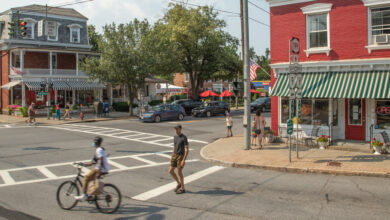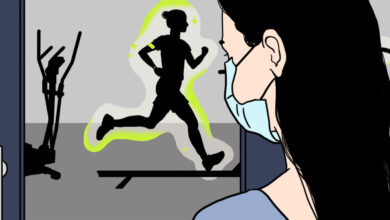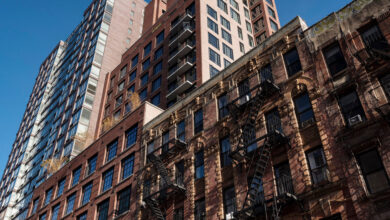Moving to the City During the Pandemic: ‘This Is the New York I Know.’

[ad_1]
Mark Hale always dreamed about living in New York, but it took a pandemic to bring him here.
Mr. Hale, who grew up just outside Philadelphia, spent 32 years in Tokyo working in project and business development for a Japanese general contracting firm, and raised a family there. Several years ago, when the firm offered him a position in Atlanta, he decided to take it. His two children were grown, his daughter lived in the U.S., and though his wife, Kiyomi, did not want to leave their son, Sei, who is now 23, or their Tokyo apartment, she would visit Atlanta for several months at a time. He also returned to Tokyo frequently for work.
But when the pandemic struck, he found himself cut off from visitors in a city that had never felt like home. “I got really lonely,” said Mr. Hale, 64. “Because I was never with family, I never took a day off. I was working seven days a week.”
But he did have family in New York City — his daughter, Emi Yasuda Hale, 30, and her husband, Viktor Mashalov, who live on the Upper West Side. So this past winter, after almost a year of isolation exacerbated by the low-density, car-centric culture of Atlanta, he arranged a transfer to his firm’s office in Midtown East.
“I wanted to be near family,” Mr. Hale said. “If I hadn’t come to New York, I would have retired in Tokyo.”
Upon hearing the news, his daughter and her husband immediately started looking for an apartment near their own. “I totally trusted her,” Mr. Hale said. “I wanted a one-bedroom, views, sunshine.”
He liked the idea of an older building, similar to the one his daughter lived in, with character and charm. He also wanted easy access to good management, a washer and dryer in the unit and a south-facing space with good light — a tricky combination to find on the Upper West Side, even with a generous company housing stipend of $5,000 a month.
As Ms. Hale put it, “There were a couple of contradictions in my father’s requests.”
Many older buildings were owned by smaller landlords, so it was hard to tell what their responsiveness would be. For example, Ms. Hale looked at one beautifully renovated condo, but the owner was overseas, which she thought would make it difficult to coordinate repairs.
Ms. Hale also knew that, after decades of living in Tokyo, her father’s expectations of building cleanliness and security were likely to be higher than those of many New York landlords. And because Mr. Hale wanted to move as soon as possible, in March, they weren’t able to wait for the perfect apartment to materialize.
In the end, they found a one-bedroom apartment in a seven-year-old, LEED-certified building on Broadway in the 70s that ticked most of the boxes: great light, an in-unit washer and dryer, attentive management and views of two beautiful old buildings: the Hotel Belleclaire and the Apthorp.
“Unfortunately, it wasn’t a very New York-ish building, but it’s good for my father,” Ms. Hale said. “It’s not what was in his heart, but it has good sunshine, is very clean and there’s an elevator.”
The elevator has been especially helpful; Mr. Hale, an avid cyclist, goes biking four or five times a week and doesn’t have to carry the bike up and down the stairs.
Because of the pandemic, the unit’s original $6,100 rent was dropped to $5,100, and the landlord offered an additional four months free on a two-year lease. Mr. Hale moved in on March 15, paying what averages out to about $4,200 a month.
About $4,200 | Upper West Side
Mark Hale, 64
Occupation: A senior manager working in business development for a Japanese general contractor.
Supermarkets: Mr. Hale’s wife, who primarily lives in the couple’s Tokyo apartment, had one request for their New York home: to be within walking distance of several supermarkets. The Hales are hoping that she can visit in June and stay through the summer.
Being within a quick train ride of friends: Mr. Hale’s two best friends from junior high never left Philadelphia. “Now that I’m back in the U.S., it’s like we never left each other. It’s magical,” he said. “We can kind of go back to being 19 years old, drinking beers and listening to music in Cape May, N.J.”
There is space in the living room for a seating area and a work area — Mr. Hale works at the office in the morning and at home in the afternoon — and also space for his two road bikes: one that he rides outside and one that he uses as a stationary bike in bad weather. With indoor and outdoor cycling options at home, the building’s gym isn’t of much interest. But he, Ms. Hale and Mr. Mashalov have enjoyed the huge rooftop terrace with Hudson River views.
From the apartment, a sliver of the river is also visible. But perhaps the best view of all, for Mr. Hale at least, is the most typically New York one: a nondescript residential building across the street.
“I’ve been reading The New Yorker for years, which has all the jokes about seeing the people in the neighboring building,” said Mr. Hale, who enjoys watching the cartoon setup come to life every evening, when his neighbors turn their lights on.
As for moving to New York during the pandemic, he’s excited to get to live in the city at all, an opportunity he hadn’t expected.
“I didn’t know New York well before Covid. This is the New York I know,” he said. “And since I moved here in March, there are more and more people going out, the restaurants are getting more crowded.”
“Last week,” he continued, “I biked over the Brooklyn Bridge into Dumbo and it was like a festival. It was wonderful. Everyone was out. In Atlanta, you bike around and there’s nobody.”
But as much as he has enjoyed the company on the streets and sidewalks, it’s the proximity to his daughter and son-in-law that has made the biggest difference. They live a three-minute walk away.
“I see them several times a week, which has completely changed my life,” he said. “For the first time since moving to the U.S., I have a work-life balance. We have dinner together once a week, watch basketball.”
Ms. Hale said it has been fun to watch her father discover new things and enjoy his life. “It’s nice to be able to see him often,” she said. “My family makes fun of me. Usually it’s the mother-in-law that comes super close after you get married.”
[ad_2]
Source link






